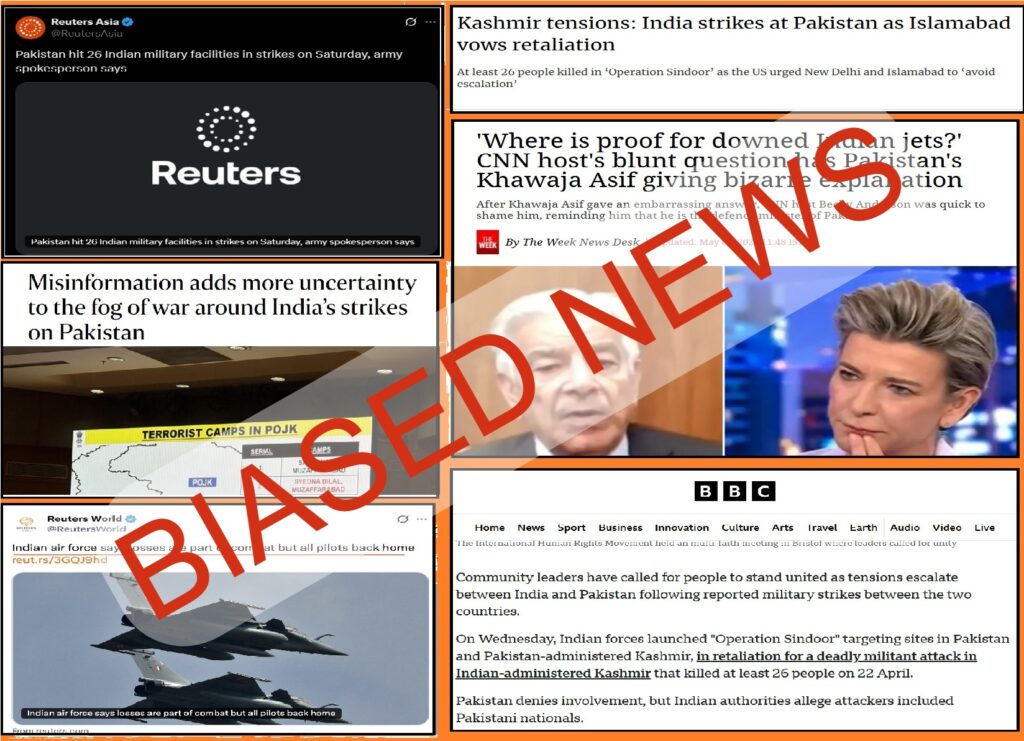
- The New York Times in the United States referred to Operation Sindoor as ‘a major escalation in the India-Pakistan conflict,’ however, it overlooked the fact that the operation was a retaliatory measure, driven by justice rather than ambition.
- Over 8,000 accounts on X were banned for propagating fake news, doctored videos, and inciting anti-India hatred, with many of these accounts traced to bot farms and troll networks operating out of Pakistan, Turkey, and even Singapore.
- Reuters initially amplified Pakistan’s bold claim of having struck 26 Indian military facilities, to which a doctored image of the Jammu air base was reported on the X platform, which was quickly debunked by independent analysts and flagged with a community note.
- Unfortunately, not all Indian media responded to the event, as a few English-language dailies, infamous for their elite appeasement and compulsive ‘both-side-ism,’ questioned the operation’s efficacy and timing, as if the lives lost in Pahalgam were to be negotiated.
On May 7, 2025, the Indian Air Force launched a precise and calculated strike, carrying out Operation Sindoor – a targeted military action in response to the tragic Pahalgam terrorist attack that took the lives of 26 innocent Indians on April 22, 2025.[1] Nine terrorist sites, located across Pakistan and Pakistan-occupied Kashmir (PoK), were demolished. The focus? Not military installations, not civilian structures, but confirmed terror bases run by Jaish-e-Mohammed, Lashkar-e-Taiba, and Hizbul Mujahideen.
India’s message was clear: acts of terror will not go unanswered, and its sovereignty will not be compromised. However, following this justified action, global media outlets, particularly many from the West and some within India, engaged in a familiar and perilous narrative. The narrative of equivocation, selective outrage and downplaying terror under the guise of “both sides.”
Let’s analyse the media and show the diabolical plan to present India in a poor light, veiled in half-truths, selective outrage, and narrative manipulation.
Western Media: The Double Standards Exposed
The New York Times in the United States referred to Operation Sindoor as “a major escalation in the India-Pakistan conflict.”[2] However, it overlooked the fact that the operation was a retaliatory measure, driven by justice rather than ambition. Prior notification to Washington clarified that this was not an unauthorised act but a sovereign response executed with restraint and precision. CNN, on the other hand, demonstrated moments of journalistic integrity. Anchor Becky Anderson directly questioned Pakistan’s Defence Minister Khawaja Asif on air, demanding proof of Pakistan’s claims that Indian jets were downed — a baseless assertion she effectively debunked in real time.[3] For once, Pakistan’s misinformation was not accepted without scrutiny.
The Western media depicted Pakistan as simply ‘retaliating’ against Indian aggression, and their coverage relied mainly on Pakistan’s victimhood narrative, reporting unverifiable civilian fatality figures without scrutinising India’s stated goals.
However, Reuters failed to uphold its journalistic standards. Reuters initially amplified Pakistan’s bold claim of having struck 26 Indian military facilities, to which a doctored image of the Jammu air base was reported on the X platform, which was quickly debunked by independent analysts and flagged with a community note stating: “No verifiable evidence has been provided by Pakistan… Alleged visual proof… has been debunked by recent satellite imagery.”
Adding to the farce, Pakistan misused Indian media footage by cropping and stripping context from India TV and Aaj Tak to build a false narrative of success. These misleading attempts were dismantled in a thread on X, which laid bare the coordinated information warfare at play. In contrast, India responded with satellite imagery showing precise damage at terror hubs in Muridke, Bahawalpur, and air bases like Nur Khan and Sukkur — cold, hard facts over theatrical claims.[4]
On the other side of the Atlantic, the BBC presented itself as a balanced voice, recognising India’s right to retaliate while also urging caution—a typical diplomatic manoeuvre in South Asian affairs. It mentioned India’s strikes on known terrorist hubs in Bahawalpur and Muridke and quoted UK officials who cautiously supported India’s actions. However, beneath this facade of impartiality was a subtle yet intentional critique of India’s sovereignty. The BBC consistently referred to Jammu & Kashmir as “India-administered Kashmir,”[5] a phrase that echoes Pakistan’s terminology and subtly challenges India’s constitutional and territorial integrity. This is not unbiased journalism—it’s narrative shaping with a British twist.
The BBC consistently referred to Jammu & Kashmir as ‘India-administered Kashmir,’ a phrase that echoes Pakistan’s terminology and subtly challenges India’s constitutional and territorial integrity.
In France, Le Monde demonstrated an unbiased insight by examining Operation Sindoor alongside India’s previous counter-terrorism actions, such as those in Uri and Balakot.[6] The publication highlighted the strategic complexity of the operation and pointed out India’s use of French-manufactured SCALP missiles launched from Rafale jets, subtly acknowledging the strong defence partnership between India and France. In contrast, Germany’s media coverage was subdued. Der Spiegel offered only brief headlines, but the general trend in German reporting was similar to that of the broader Western media, showing cautious support for India’s counter-terror efforts without resorting to alarmist tones.
Singapore and SCMP: Subtle Bias, Loud Impact
If the West’s coverage was erratic, some Asian outlets behaved worse, not by what they stated, but by what they indicated. The Straits Times and CNA (Channel News Asia) of Singapore have been extensively condemned on social media, and properly so. Their framing depicted Pakistan as simply “retaliating” against Indian aggression.[7] Their coverage relied mainly on Pakistan’s victimhood narrative, reporting unverifiable civilian fatality figures without scrutinising India’s stated goals. X User Aravind’s post[8] on May 10 pointed out this bias: “The Straits Times is promoting Pakistani propaganda and building a narrative of Pakistan’s ‘victory’ in the skirmishes.” The comments section was inundated with anti-India rhetoric, fueled by misleading bots and agenda-driven accounts.
Despite being headquartered in Hong Kong, the South China Morning Post (SCMP) frequently represents Beijing’s point of view. Their coverage began with Pakistan’s claim of 26 civilian casualties and infrastructure damage, including a hydroelectric plant. There was scant focus on the nature of Indian targets – terror camps rather than civilian areas — which supported Pakistan’s favoured narrative of victimisation. Once again, selective facts, exaggerated headlines, and dangerous misconceptions.[9]
There was scant focus on the nature of Indian targets – terror camps rather than civilian areas, which supported Pakistan’s favoured narrative of victimisation.
Israel: A Consistent Voice of Support
In stark contrast, Israeli media has emerged as a source of clarity and solidarity. Israel’s Ambassador to India, Reuven Azar, made a daring comment on X: “Israel supports India’s right to self-defence. Terrorists should understand that there is no place to hide from their horrible crimes.[10]
Israeli media coverage went further, linking Operation Sindoor to the 2002 assassination of American-Jewish journalist Daniel Pearl by Pakistani terrorists. According to the Economic Times, Abdul Rauf Azhar, one of the key suspects in Pearl’s case, was targeted in the May 7 attacks, making Sindoor a symbol of long-overdue justice.[11] In an increasingly transactional world of diplomacy and media, this was more than just support; it was moral clarity.
Fighting Back: India’s Digital Response
The Indian government was not happy with simply correcting military records. In the age of information warfare, fighting disinformation is just as important as firing a missile. Recognising this, the Ministry of Information and Broadcasting, in collaboration with cybersecurity organisations, conducted a comprehensive digital cleanup.[12]
Over 8,000 accounts on X were banned for propagating fake news, doctored videos, and inciting anti-India hatred.[13] Many of these accounts were traced to bot farms and troll networks operating out of Pakistan, Turkey, and even Singapore. The message was clear: India’s narrative will not be hijacked by propaganda. Facts will not be drowned by fiction. And sovereignty extends to cyberspace.
The Indian Media’s Own Weak Knees
Unfortunately, not all Indian media responded to the event. A few English-language dailies, infamous for their elite appeasement and compulsive “both-side-ism,” questioned the operation’s efficacy and timing, as if the lives lost in Pahalgam were to be negotiated. Some even published op-eds claiming that India “could have shown restraint,” conveniently forgetting that forbearance was what led to Pulwama in the first place.[14]
This portion of the Indian media failed to grasp that when your military bleeds, your civilians die, and your boundaries are tested, there is no room for intellectual gymnastics. There is only justice, or the absence of it.
Conclusion: A Nation Asserts, The World Watches
Operation Sindoor was not merely a military effort. It was a declaration that India will strike, speak, and stand firm when its dignity is threatened. The global media, with its prejudices and occasional flashes of honesty, attempted to shape the story. But this time, India was prepared—militarily, politically, and digitally.
From the skies over PoK to the servers that control X accounts, India demonstrated that sovereignty is more than a word; it is a policy. And to the global press, which is still addicted to moral equivalence, terrorism is not a point of view. It’s a crime.
References:
- [1] Operation Sindoor: Over 100 terrorists including high-value targets killed in May 7 strikes, says DGMO
- [2]The Symbolism Behind India’s ‘Operation Sindoor’
- [3] Where is proof for downed Indian jets?’ CNN host’s blunt question has Pakistan’s Khawaja Asif giving bizarre explanation
- [4] https://x.com/ConsOfMedia/status/1921799828498948119
- [5] ‘We need to stand united’ amid India-Pakistan conflict
- [6]Operation Sindoor: Understanding Context and Consequences
- [7] Misinformation adds more uncertainty to the fog of war around India’s strikes on Pakistan
- [8] https://x.com/aravind/status/1921038654631301312
- [9] Kashmir tensions: India strikes at Pakistan as Islamabad vows retaliation
- [10] Israel backs India’s ‘right to self defence’ following Operation Sindoor
- [11] How India’s Operation Sindoor in Bahawalpur delivered the justice denied to Daniel Pearl in Pakistan
- [12] I&B Ministry advises media to refrain from live coverage of defence operations
- [13] Operation Sindoor: India gave executive orders to block over 8k accounts, says X
- [14] https://x.com/MinhazMerchant/status/1921125633700028916
Pranav S is a Project Assistant at the Energy Department, Government of Karnataka with an MA in Public Policy. Views expressed are the author’s own.
